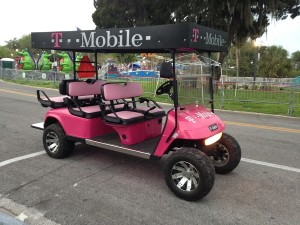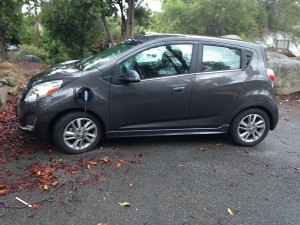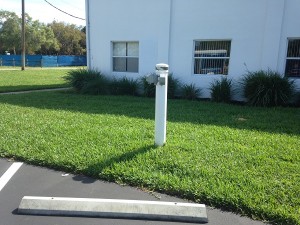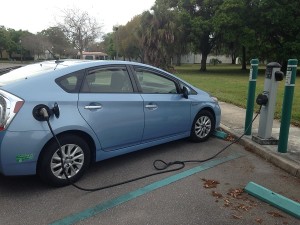Last week, I mentioned that there is a broader issue related to the issue of allowing golf carts on city streets. That is the issue of making our city attractive to owners of NEVs, PiHs/EREVs, and EVs. I learned quite a bit about these vehicles from my son, who had both a Prius Plugin and a Chevy Spark EV while he and his wife were living in California. Steven turned in his leased Spark EV when he received orders to move to Japan. I’m “car sitting” the Prius.
Because this discussion can easily turn a bit “geeky”, let’s start off with some definitions:
Neighborhood Electric Vehicles (NEV) – These electric vehicles typically top out at about 25 miles per hour and are appropriate for most city streets, but not faster roads like US 19. Some golf carts qualify as NEVs. Polaris Industries markets the GEM line of electric vehicles that are sometimes seen around New Port Richey. NEVs fall under a federal vehicle class called “Low-Speed Vehicles”. In a walkable / bike friendly New Port Richey, NEV’s fit right in as an option for folks who don’t want the expense of a conventional vehicle.
Plug In Hybrids (PiH) / Extended Range Electric Vehicles (EREV) – Examples are the Toyota Prius Plugin, Ford Fusion Energi and the Chevrolet Volt. They have gasoline engines that kick in after the battery is discharged. The difference between them is that the Plug In Hybrids (eg. Toyota Prius Plugin) typically have a very limited electric range, about 14 miles on the Prius, and the Extended Range Electric Vehicles (eg. Chevy Volt) are designed to spend most of their time using electricity, with an electric range of 38 – 53 miles. These vehicles can travel at highway speeds.
Electric Vehicles (EV) – These vehicles don’t have gasoline engines at all. The Nissan Leaf, the Tesla S, the Spark EV my son had in California, and the upcoming Chevy Bolt are examples. I’ve seen someone tooling around town in a Leaf. The Leaf has a published range of about 70 miles on a charge. The Bolt, due here later this year, will reportedly have a range of 200 miles on a charge, making it an option for quite a few people. These vehicles can also travel at highway speeds. Because they don’t have all the mechanical parts inherent in a gasoline vehicle, they have far lower maintenance and operating expense associated with them.
All three of these types of electric vehicles are available in West Pasco today, with more models (eg. the Bolt) likely to arrive before the end of the year. Given the growing availability of these vehicles, the obvious question becomes: “Where do you plug these things in?” Most owners will do most of their recharging at home, probably using the 110 volt charging cable that comes with the vehicle. Some owners will spring for the faster charging available by installing a Level 2 charger in their garage.
Public Charging Stations – There are three general types of public charging stations:
Level 1 – Level 1 stations are essentially 110 volt power plugs mounted to posts in front of parking spaces.
Level 2 – Level 2 stations provide 220 volt power through a special cord and plug that fits into the charging port on the vehicle. Level 2 charging stations can recharge an EV faster than a Level 1 charging station. These stations can be installed for a few thousand dollars each.
Fast Charging Stations – These are very expensive (15-60k) designed to quickly recharge an EV, often in a matter of minutes.
To the best of my knowledge, there is only one public Level 1 station within the New Port Richey city limits. It is in the parking lot of the First United Methodist Church and it isn’t properly marked. As a result, you will like as not see gasoline powered cars in the two spaces closest to the power post.
There do not appear to be any public Level 2 stations in the city.
There is one fast charging station in the city. It is in the back of the Quality Inn and has a $7 per hour price to use it, with a one hour minimum. While that might work for fast charging a Tesla, it is overkill and too expensive to use with the Prius.
Nationwide, there are over 400,000 EV and plugin vehicles on the road today. Surprisingly, Florida has quite a few of them even though some models aren’t sold here. I predict that these vehicles will become mainstream over the next five to ten years as it becomes clear that they are MUCH less expensive to operate. That change is already starting: One of my friends has her name on the waiting list for the Prius Prime, a plugin hybrid, due out later this year. Friday’s Tampabay Times had an article about people lining up by the hundreds Thursday to put down deposits for a Tesla model that won’t be here for nearly two years!
Would charging stations downtown make a difference today? Probably not. On the other hand, they almost certainly will make a difference as more of these vehicles hit the roads around West Pasco over the next few years. I believe I could make a pretty good case for charging stations in at least a couple of the downtown parking lots, plus in the city hall / library parking lot.
Businesses across the country are starting to install charging stations. Both Publix and Walgreens have charging stations at stores in the Tampa Bay area, although neither have one at any of their West Pasco locations yet. The Publix stations are free to use. Walgreens charges a nominal amount per hour for using their stations.
So what does all of this mean to us? I believe that the trend is clear enough that we need to start planning for the demand we will see in the near future. It won’t hurt that it will also position New Port Richey as a forward thinking community.
We ought to be planning for both Level 1 and Level 2 stations as NEVs are going to typically use only the Level 1 stations and the other vehicles can take advantage of the faster charging available with a Level 2 station.
Oldsmar recently installed four Level 2 public charging stations in town, making it the first Tampa Bay community to take this step.
I mentioned the lack of charging stations to our city manager a couple of months back in connection with our consideration of both the proposed golf cart ordinance and the proposed parking garage. If we are going to encourage owners of electric vehicles to come downtown, we probably ought to make it possible for them to recharge while they are here. One of the candidates for city council mentioned the need for charging stations during the candidate forum a couple of weeks ago.
A company by the name of Chargepoint currently operates the largest network of charging stations in the country. The Oldsmar stations are part of the network. You recharge your car by waiving an RFID card at the terminal and plugging in your car. You waive the card a second time to finish charging and you then return the plug to the charging station.
Chargepoint stations can be set up to charge for use and could even be a modest revenue generator for the city or businesses that choose to install them. It cost me a dollar to charge the Prius while I walked around Oldsmar. An app on my phone kept me posted about the charging progress while I stopped in to a fast food place to grab a soft drink.
Businesses in New Port Richey may be able to use the city grant program to help underwrite the cost of installing charging stations. Interested businesses should contact Mario Iezzoni in the city’s economic development office for details on how to apply.
If we are looking to attract the sort of folks that would be attracted to one of these vehicles, we need to consider investing in things that would encourage them to come downtown, such as charging stations.
The future will be here before we know it.
Rob Marlowe, Mayor





I think that it’s a great idea to have charging stations scattered about the city. Maybe a couple at the Rec center, Sims park and other parks as well and a few in the downtown area parking lots. I’ve been for this since the Tampa Bay Regional Planning Council installed a couple a number of years ago in their parking lot. Nobody was interested in doing that here at the time. I could use a level 1 charging station for my NEV Gem although I live so close to everything in the city my charge at home has always lasted me more than enough. Like you say, there are several of us with Gem NEVs which are “street legal” both licensed and insured unlike a golf cart.
I started this article last weekend. Little did I know that Tesla would pick up over 198,000 $1000 deposits on their Model 3 on Thursday and Friday. The demand for EVs is definitely here.
The Rec. Center is another great idea for a charging station location.
I’m one of the 198,000.
I’m leaning more toward the Chevy Bolt, which will be out a year earlier than the Tesla Model 3. The Chevy Volt would also work well for my type driving, since a 50 mile electric range would cover most of my needs with the gas engine covering the longer trips. I drove Steven’s Prius out to River Ridge yesterday using the engine and then came all the way back electric only. The 14 mile electric range wouldn’t have quite done the trick for a round trip.
The Leaf doesn’t have quite the range I’d need in a pure EV. The Model 3 or the Bolt, with a 200 mile range, would cover my needs nicely.
Thanks for the article, Rob. I might be interested in setting up a charging station in our back parking lot. During this weekends events, someone parked across the street and ran a 100 foot extension from the outlet in back of our offices across Bridge Road to their vehicle (without asking, of course). It turns out they were only charging their battery with a trickle charger
Jim,
It isn’t difficult. To have a Level 1 charging station, you really only need a convenient plug and a designated parking space. A Level 2 station is a bit more complicated and expensive, since you need both 220volt service and a J1772 connector, in addition to the designated parking place.
Of course, if you get yourself an EV, you can charge up each day at work! I plugged Steven’s car in at my office while I went over to Cornerstone for pizza for supper last night.